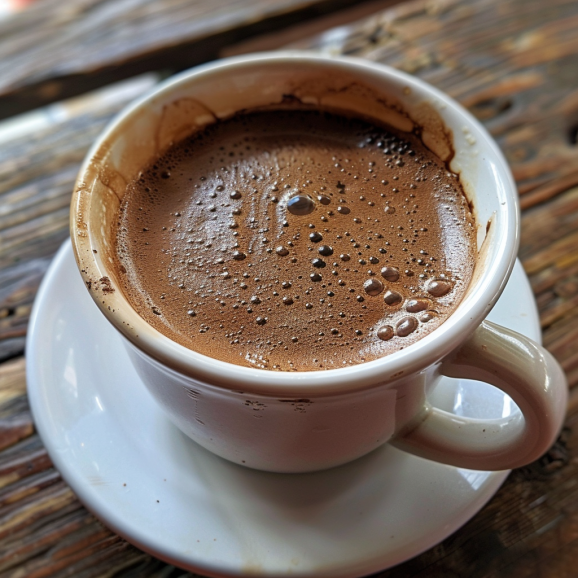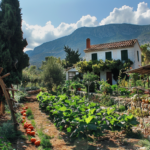
The briki, a quintessential element of Greek culinary tradition, is much more than just a coffee pot. It is the cornerstone of Greek coffee culture, embodying a centuries-old tradition that is as much about community and conversation as it is about the coffee itself. This small, distinctive pot is instrumental in brewing Greek coffee, known for its strong flavor and rich foam—a true staple in Greek households.
The Design of a Briki
A briki is uniquely designed to maximize the flavor and quality of Greek coffee. Its narrow top and wide, shallow bottom allow for optimal heat distribution, ensuring the coffee heats slowly and evenly. This design is crucial for properly brewing Greek coffee, which needs to be brought to a boil several times before serving. The long handle keeps the user’s hand away from the heat source, making it practical and safe for daily use.
How to Use a Briki
Making Greek coffee is an art form that requires patience and precision, and the briki is central to this process. Here’s a basic guide on how to use a briki to make traditional Greek coffee:
- Measure the Water: Pour cold water into the briki, typically about one demitasse cup per serving.
- Add Coffee and Sugar: Add one heaping teaspoon of finely ground Greek coffee per cup. Sugar is added according to taste: none for ‘sketo’, a little for ‘metrio’, and a lot for ‘glyko’.
- Mix and Heat: Stir the coffee and sugar together with the water until well mixed. Place the briki on low heat on your stove. Allow the coffee to heat slowly; do not stir after placing it on the heat.
- Watch for the Foam: As the coffee heats, a thick foam, known as “kaimaki”, will form on top. Just as the coffee starts to rise and the foam nears the rim of the briki, remove it from the heat.
- Serve Immediately: Pour the coffee into a cup, ensuring that the foam is evenly divided between the cups.
The Ritual of Greek Coffee
Drinking Greek coffee is not just about caffeine; it’s a ritualistic experience that fosters social interaction. Traditionally, Greek coffee is served with a glass of water and is meant to be sipped slowly, often accompanied by lively conversation or quiet reflection. This ritual is an integral part of the day in many Greek homes, symbolizing hospitality and a break from the rush of life.
Conclusion
The briki is more than a tool for making coffee—it’s a symbol of Greek hospitality and a testament to the importance of tradition in Greek culture. Through the briki and the ritual of making Greek coffee, bonds are strengthened, and cultural heritage is celebrated. Whether you’re a longtime aficionado or a newcomer to Greek coffee, using a briki can transform your coffee experience into something truly special.
FAQ: Making Greek Coffee with a Briki
Q1: What is a briki and why is it special? A1: A briki is a traditional Greek coffee pot, distinguished by its long handle and narrow top, which is specifically designed for making Greek coffee. Its shape allows for optimal heat distribution, crucial for brewing Greek coffee correctly and achieving the characteristic thick foam.
Q2: What kind of coffee should I use with a briki? A2: Use finely ground Greek coffee, which is specifically ground finer than espresso. This type of coffee is designed to be brewed in a briki and is crucial for achieving the correct flavor and foam.
Q3: How much coffee and water do I need? A3: Typically, you use one demitasse cup of cold water and one heaping teaspoon of Greek coffee per serving. Adjust the quantities based on how many cups you are preparing.
Q4: Should I stir the coffee while it’s heating? A4: Stir the coffee only once when you initially mix the coffee, water, and sugar before heating. Once on the heat, do not stir it again as this can prevent the formation of the desired foam.
Q5: How do I know when the coffee is ready to be removed from the heat? A5: Watch for the coffee to form a thick foam, and as soon as the foam rises to the top of the briki, remove it from the heat immediately to prevent it from boiling over.
Q6: How do I serve Greek coffee? A6: Pour the coffee slowly into a small coffee cup, making sure to distribute the foam evenly among the cups. It’s traditionally served with a glass of water on the side.
Q7: What is the proper way to drink Greek coffee? A7: Greek coffee should be sipped slowly to enjoy its flavor and to allow the grounds to settle at the bottom of the cup. It is often enjoyed as part of a longer, social experience rather than a quick caffeine fix.
Q8: Can I add milk to Greek coffee? A8: Traditional Greek coffee is not served with milk. It is enjoyed black, with sugar added for sweetness if preferred.
Q9: What do I do with the coffee grounds left at the bottom of the cup? A9: The grounds are left in the cup and should not be consumed. They will settle at the bottom of the cup as you drink the coffee.
Q10: Can I reuse the coffee grounds for another cup? A10: No, the coffee grounds cannot be reused. Each brew requires fresh grounds to maintain the quality and flavor of the coffee.
Discover Must-Have Greek Coffee Serving Essentials
Uncover the art of Greek coffee preparation and elevate your coffee experience with these essential tools and accessories. Sponsored by Digital Heroes Caffe and Financial Navagator 360, we invite you to explore the world of Greek coffee culture and the must-have items that enhance this cherished tradition.
Greek Mezes Recipe: Where Flavor Meets Tradition
Before diving into the world of Greek coffee, begin your journey with Greek Mezes Recipe. Explore an array of traditional Greek mezes, perfect for complementing your coffee moments.
Dolmades: Greek Stuffed Vine Leaves Unveiled
Discover the intricate flavors of dolmades, a delicacy that pairs wonderfully with Greek coffee. Explore Dolmades to unravel the secrets behind this beloved Greek dish.
YouTube Chef on a Bike: Your Culinary Companion
For a comprehensive culinary experience, Chef on a Bike offers a rich collection of authentic Greek recipes and interactive cooking sessions. Join passionate Greek chefs as they share the essence of Greek cuisine.
Anna-Maria Barouh: A Culinary Journey
Immerse yourself in the culinary insights and expertise of Anna-Maria Barouh at Anna-Maria Barouh. Her passion for Greek cuisine adds depth to your exploration of Greek coffee and its serving essentials.
From coffee pots to traditional cups, explore the tools that transform Greek coffee into a ritual. Whether you’re a coffee connoisseur or new to this aromatic world, our mission is to bridge the gap between tradition and innovation, offering you a taste of Greece’s rich coffee heritage. Join us as we celebrate the love for hearty Greek meals, the aroma of fresh herbs, and the camaraderie that accompanies every sip.


















